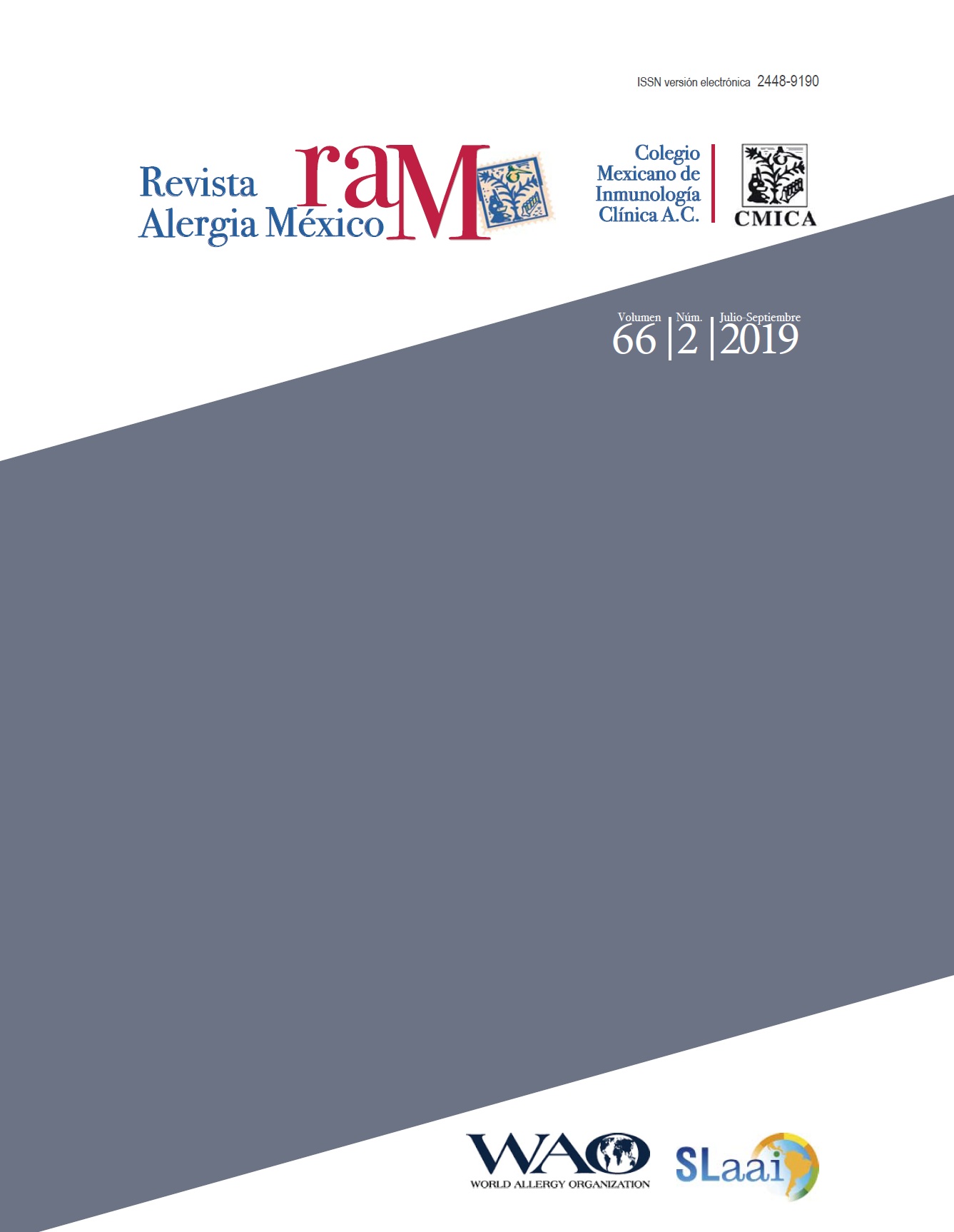Abstract
Background: The fern test is a method for assessing the characteristics of the nasal section in the treatment of patients with mucous dysfunction of the airway.
Objective: The aim of this study was to investigate the role of the fern test in patients with rhinitis and to assess the classification of each type of rhinitis (types I-IV) in clinical practice.
Methods: A cross-sectional study, which included consecutive patients from a third level Rhinology Unit, worked with 182 patients with rhinitis and 30 healthy subjects as control. The patients were subdivided according to their type of rhinitis: allergic rhinitis (59), infectious rhinitis (32), polyps (31), NARES (Non-allergic rhinitis with eosinophilia syndrome) (30) and NARNE (non-allergic rhinitis with neutrophils) (30).
Results: The control subjects had only type I or II rhinitis, whereas patients with rhinitis usually showed type III or IV. Allergic rhinitis and nasal polyps had the most serious deterioration according to the fern test (type IV).
Conclusions: The fern test is effective for assessing mucus alterations in patients with rhinitis and it could be included as a new parameter in the study of rhinitis as a potential biomarker of the function of damaged epithelial cells.
References
Bansil R, Turner BS. The biology of mucus: composition, synthesis and organization. Adv Drug Deliv Rev. 2018;124:3-15. DOI: 10.1016/j.addr.2017.09.023
Taherali F, Varum F, Basit AW. A slippery slope: on the origin, role and physiology of mucus. Adv Drug Deliv Rev. 2018;124:16-33. DOI: 10.1016/j.addr.2017.10.014
Lang T, Klasson S, Larsson E, Johansson ME, Hansson GC, Samuelsson T. Searching the evolutionary origin of epithelial mucus protein components-mucins and FCGBP. Mol Biol Evol. 2016;33(8):1921-1936. DOI: 10.1093/molbev/msw066
Cone RA. Barrier properties of mucus. Adv Drug Deliv Rev. 2009;61(2):75-85. DOI: 10.1016/j.addr.2008.09.008
Silberberg A. On mucociliary transport. Biorheology. 1990;27(3-4):295-307. DOI: 10.3233/BIR-1990-273-408
Neutra MR, Forstner JF. Gastrointestinal mucus: synthesis, secretion, and function. In: Johnson LR (editor). Physiology of the gastrointestinal tract. EEUU: Raven Press; 1987.
Quraishi MS, Jones NS, Mason J. The rheology of nasal mucus: a review. Clin Otolaryngol Allied Sci. 1998;23(5):403-413. DOI: 10.1046/j.1365-2273.1998.00172.x
Lai SK, Wang YY, Wirtz D, Hanes J. Micro- and macrorheology of mucus. Adv Drug Deliv Rev. 2009;61(2):86-100. DOI: 10.1016/j.addr.2008.09.012
Carlstedt I, Sheehan JK. Structure and macromolecular properties of cervical mucus glycoproteins. Symp Soc Exp Biol. 1989;43:289-316.
Thornton DJ, Sheehan JK. From mucins to mucus: toward a more coherent understanding of this essential barrier. Proc Am Thorac Soc. 2004;1(1):54-61. DOI: 10.1513/pats.2306016
Papanicolaou GN. Mucus test. Anat Rec. 1945;91:293.
Roland M. A simple test for the determination of ovulation, estrogen activity, and early pregnancy using the cervical mucus secretion; a preliminary report. Am J Obstet Gynecol. 1952;63(1):81-89. DOI: 10.1016/S0002-9378(16)38983-9
Zondek B, Rozin S. Cervical mucus arborization; its use in the determination of corpus luteum function. Obstet Gynecol. 1954;3(5):463-470. DOI: 10.1097/00006254-195508000-00049
Abou-Shabanah EH, Plotz EJ. A biochemical study of the cervical and nasal mucus fern phenomenon. Am J Obs Gynecol. 1957;74(3):559-568. DOI: 10.1016/0002-9378(57)90508-2
Rolando M. Tear mucus ferning test in normal and keratoconjunctivitis sicca eyes. Chibret Int J Ophthalmol. 1984;2:33-41.
Rolando M, Baldi F, Zingirian M. The effect of hyperosmolarity on tear mucus ferning. Fortschr Ophthalmol. 1986;83(6):644-646.
Rolando M, Baldi F, Calabria G. Tear mucus crystallization in children with cystic fibrosis. Ophthalmologica. 1988;197(4):202-206. DOI: 10.1159/000309944
Kalayci D, Kiper N, Ozcelik U, Gocmen A, Hasiripi H. Clinical status, ocular surface changes and tear ferning in patients with cystic fibrosis. Acta Ophthalmol Scand. 1996;74(6):563-565. DOI: 10.1111/j.1600-0420.1996.tb00735.x
Horwath J, Ettinger K, Bachernegg M, Bodner E, Schmut O. Ocular Ferning Test - effect of temperature and humidity on tear Ferning patterns. Ophthalmologica. 2001;215(2):102-107. DOI: 10.1159/000050838
Lavaud MC, Trouillas J. The mucus: a medium of life. Gynecol Obstet Fertil. 2012;40(1):19-23. DOI: 10.1016/j.gyobfe.2011.07.031
Gelardi M. Atlas of nasal cytology. Second edition. Milan, Italy: Edi Ermes; 2012.
Gelardi M, Fiorella ML, Russo C, Fiorella R, Ciprandi G. Role of nasal cytology. Int J Immunopathol Pharmacol. 2010;23(Suppl 1):45-49.
Gelardi M, Maselli-Del-Giudice A, Fiorella ML, Fiorella R, Russo C, Soleti P, et al. Non-allergic rhinitis with eosinophils and mast cells constitutes a new severe nasal disorder. Int J Immunopathol Pharmacol. 2008;21(2):325-331. DOI: 10.1177/039463200802100209
Gelardi M, Iannuzzi L, De-Giosa M, Taliente S, DeCandia N, Quaranta N,et al. Non-surgical management of chronic rhinosinusitis with 1 nasal polyps based on clinical cytological grading: a precision medicine-based approach. Acta Otorhinolaryngol Ital. 2017;37(1):38-45. DOI: 10.14639/0392-100X-1417
Rolando M. Tear mucus ferning test in normal and keratoconjunctivitis sicca eyes. Chibret Int J Ophthalmol. 1984;2:32-41.

This work is licensed under a Creative Commons Attribution-NonCommercial 4.0 International License.
Copyright (c) 2019 Revista Alergia México





